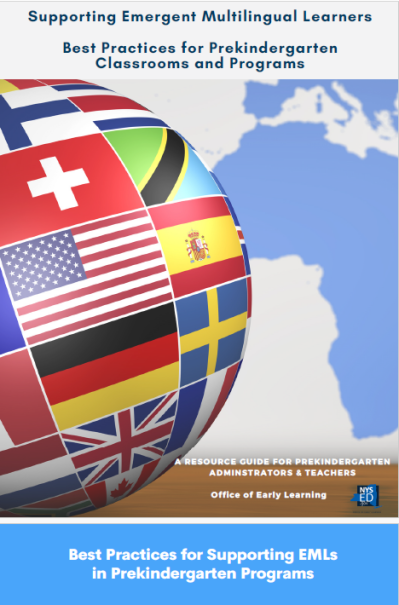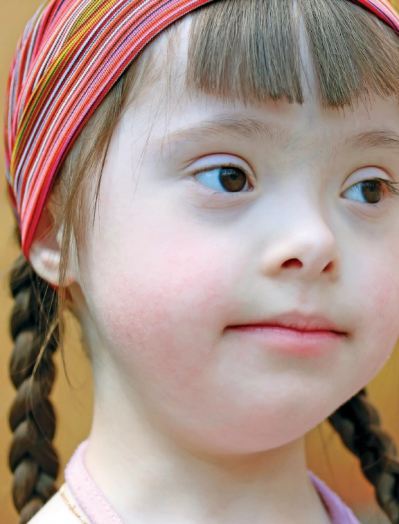Supporting Special Populations
Please see the resources described below as well as blueprints for Improving Results for Students with Diverse Needs and applicable regulations.
Emergent Multilingual Learners
Multilingual Learner (ML) includes identified English Language Learners (ELLs) in grades K-12, Former or Ever ELLs, heritage speakers of World Languages, and students pursuing a course of study in one or more World Languages. Therefore, every student who is or seeking to be language diverse regardless of English language proficiency is a Multilingual Learner. This includes our Emergent Multilingual Learners (EMLs) in prekindergarten as these students are heritage speakers of World Languages.
EMLs are prekindergarten students who enter prekindergarten with a home or primary language other than English. EMLs bring rich cultural and linguistic experiences to the prekindergarten classroom. These valued resources should be used to scaffold learning and can contribute significantly to academic achievement in prekindergarten and beyond.
To be responsive to the diverse needs of EMLs and their families, New York State Education Department (NYSED) has developed the EML Profile. This tool helps educators by identifying students’ existing language(s) and linguistic experiences so that classrooms, instruction, and programming are responsive and relevant. For more information and resources that support EMLs and their families, visit the Emergent Multilingual Learners in Prekindergarten Programs webpage.
Supporting Emergent Multilingual Learners- Best Practices for Prekindergarten
This guidance was designed to support programs and classrooms in implementing practices for developing the language and literacy of Emergent Multilingual Learners through culturally responsive approaches.
Preschool Children with Disabilities
Some children who have diagnosed conditions, or disabilities that are medical, physical, developmental or psychological may need more support to progress in one or more developmental areas.
A Resource to Special Education Support Services from Birth to Third Grade is a guide to navigate the special education system for children from birth to third grade. It includes an overview of the Early Intervention Program (EIP) and programs and services available to preschool children and school age students with disabilities in New York State.
The Office of Special Education works to promote educational equity and excellence for students with disabilities through its roles and responsibilities to oversee the implementation of federal and State laws and policy for students with disabilities, provide general supervision and monitoring of all public and private schools serving New York State preschool and school-age students with disabilities, establish a broad network of technical assistance centers and providers to work directly with parents and school districts to provide current information and high quality professional development and technical assistance to improve results for students with disabilities, ensure a system of due process, including special education mediation and impartial hearings, and meet with stakeholders through the Commissioner's Advisory Panel for Special Education Services.
McKinney-Vento Students
It can be challenging to enroll and retain preschoolers experiencing homelessness because families in temporary housing may move frequently. State-administered prekindergarten programs offer a crucial opportunity for young children to develop their social, emotional, and cognitive skills. Unfortunately, they often face barriers to accessing these programs and participate at lower rates than their permanently housed peers.
To help address this, state-administered prekindergarten programs have certain responsibilities to identify and support children experiencing homelessness. School districts have to provide transportation for children who are homeless to attend a state-administered prekindergarten program that they enrolled in or registered for before they became homeless. For further information, please refer to the 2019 memo from the New York State Commissioner of Education. Pursuant to McKinney-Vento, children experiencing homelessness must have equal access to the same free, appropriate public education, including a public preschool education. Pursuant to McKinney-Vento, districts must ensure that such children receive educational services for which they are eligible, including preschool programs administered by the district. To this end, McKinney-Vento requires Districts to develop, review and revise policies to remove barriers to the enrollment and retention of students in temporary housing, including preschoolers. Moreover, each district is required to appoint a McKinney-Vento liaison to serve students in temporary housing. To learn more about McKinney-Vento liaisons, please visit NYS TEACHS Liaisons.
Children in temporary housing may find that Pre-K programs near them are full or have long waiting lists, especially if a child’s family moves mid-year. Because McKinney-Vento requires that districts eliminate barriers to the full participation and success in school for students in temporary housing, it is especially important that districts engage in proactive steps, such as those listed below, to ensure that children are able to access Pre-K programs.
- Districts are encouraged to explore funding sources, such as Title I3 or McKinney-Vento grants, to cover the cost of additional staff members to increase class sizes to 19 or 20 Pre-K students. In order to enroll 19 or 20 students in a Pre-K class, the class must have one teacher and two paraprofessionals.
- Submit a class-size variance to the Director of the Office of Early Learning to increase the class size above 20 students if a child in temporary housing seeks to enroll in a class that has already reached its maximum capacity of 20 students per Commissioner's Regulations.
Please refer to McKinney-Vento Homeless Education and NYSED’s homeless education technical assistance center, NYS-TEACHS, for more information and resources. Below are additional resources:
- Identification using a Housing Questionnaire: All state-administered prekindergarten programs must identify and report data on the housing status of children enrolled in their program. There are two templates available: Housing Questionnaire for school districts and Housing Questionnaire for Head Start and other early care providers.
- Supporting Children and Families Experiencing Homelessness: This interactive learning series, provided by the Head Start Early Childhood Learning and Knowledge Center, is intended for professionals in early childhood to help them learn how to identify families experiencing homelessness, conduct community outreach, and much more.
- Early Care and Education Services in New York State for Young Children Experiencing Homelessness: This resource will help early childhood educators identify the early care and education services in their communities and enable them to better connect parents who are homeless with the highest quality services for their young children.









